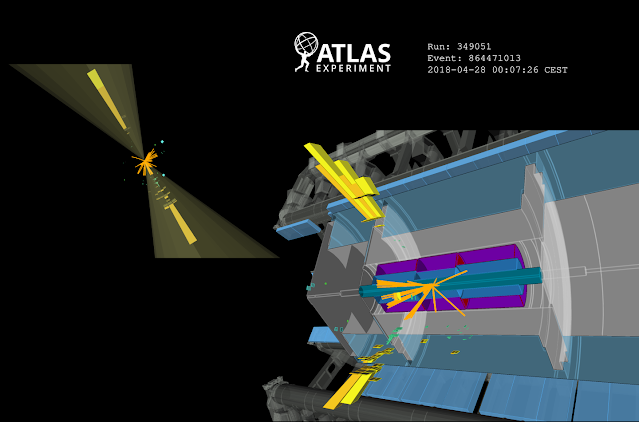CERN - European Organization for Nuclear Research logo.
March 22, 2022
Physicists at the ATLAS experiment are on the hunt for new, long-lived particles to help explain several outstanding mysteries of our Universe
Image above: ATLAS event display for a data event with a pair of “displaced jets”, which are narrow, largely trackless and have most of their energy in the hadronic part of the calorimeter. (Image: CERN).
High-energy collisions at the Large Hadron Collider (LHC) allow researchers to clearly study heavy Standard Model particles, like the Higgs boson, that decay almost immediately at the LHC collision point. However, new long-lived particles (LLPs) could travel sizeable distances through the ATLAS detector before decaying.
Studying the decay of any particle is a complex task, but it is usually made much easier by assuming that it decayed near the LHC collision point. This leaves LLPs in a blind spot, as they could decay anywhere in the detector. To ensure no stone is left unturned, ATLAS physicists have devised a range of new strategies to look for LLPs with various possible characteristics.
The hunt for right-handed neutrinos
Neutrinos have long puzzled physicists, as they have only ever been observed to be “left-handed” (i.e. their spin and momentum are opposed), while all other particles can also be observed in “right-handed” states. One possibility is that right-handed neutrinos exist but are very heavy, and therefore harder to produce in nature. These particles – called “heavy neutral leptons” (HNLs) – could also explain why neutrinos are so light.
In a new search for HNLs, ATLAS physicists looked for leptons originating from a common point a short distance from the collision point. The HNL could have decayed to a mixture of electrons, muons and missing energy. Using the decay products, they reconstructed the possible HNL mass and were able to set limits on masses between 3 and ~15 GeV. They also reported on HNL decays to electron–muon pairs for the very first time!
Harnessing the power of machine learning
If a new, neutral LLP were to decay to quarks in the outer layers of the calorimeter, it would leave behind sprays of collimated particles called “displaced” jets. These would leave an unusual signature in the detector: the jets would have no associated particle trajectories and would be very narrow compared to their Standard Model counterparts (see event display).
ATLAS researchers have exploited the uncommon characteristics of displaced jets to search for pairs of neutral LLPs. They developed novel machine-learning methods to distinguish displaced jets from background interactions. No significant excess of events has been spotted so far.
But what if the neutral LLP decays to leptons instead of quarks? “Dark photons” are a type of LLP believed to behave this way, and would leave behind collimated sprays of leptons in the detector, called “lepton-jets”. ATLAS’s newest search for dark photons uses machine-learning techniques that exploit patterns of raw energy deposits in each layer of the detector – a first for the collaboration. Although no excess of events was seen, physicists set stringent new limits on the existence of dark photons and were able to probe dark-photon decays to electrons for the very first time!
Following the steps of charged LLPs
When searching for new particles, physicists have to look for their decay products – or do they? If a heavy charged LLP exists, it would leave abnormally large energy deposits in the ATLAS tracking detector. This is an exceptional case where physicists could actually detect a new particle directly.
Graphic above: Result of the ATLAS search for a heavy charged LLP. The observed data (black) agree with the Standard Model expectation (blue line), except for a small excess of events in a high-energy and high-mass region (above 1000 GeV). (Image: ATLAS collaboration/CERN).
However, predicting the Standard Model background processes in this search is very challenging. To tackle the problem, ATLAS physicists employed a sophisticated “data-driven” method using tracks with regular energy deposits for comparison. The observed data agree with the Standard Model expectation, except for a small excess of events in a high-energy and high-mass region (see figure). Although intriguing, the measurements made indicate that none of the candidate events match the heavy new particle hypothesis. New searches in the works, and additional data, could shed more light on it.
Into Run 3
At the heart of these analyses is one key question: what if new particles are hiding from standard searches? ATLAS researchers have developed novel, creative ways to explore the rich diversity of possible LLP decays. The search continues, with Run 3 of the LHC promising new data and new innovations to further this exciting programme of research.
Note:
CERN, the European Organization for Nuclear Research, is one of the world’s largest and most respected centres for scientific research. Its business is fundamental physics, finding out what the Universe is made of and how it works. At CERN, the world’s largest and most complex scientific instruments are used to study the basic constituents of matter — the fundamental particles. By studying what happens when these particles collide, physicists learn about the laws of Nature.
The instruments used at CERN are particle accelerators and detectors. Accelerators boost beams of particles to high energies before they are made to collide with each other or with stationary targets. Detectors observe and record the results of these collisions.
Founded in 1954, the CERN Laboratory sits astride the Franco–Swiss border near Geneva. It was one of Europe’s first joint ventures and now has 23 Member States.
Related links:
Large Hadron Collider (LHC): https://home.cern/science/accelerators/large-hadron-collider
Large Hadron Collider beauty (LHCb): https://lhcb-public.web.cern.ch/
ATLAS: https://home.cern/science/experiments/atlas
For more information about European Organization for Nuclear Research (CERN), Visit: https://home.cern/
Image (mentioned), Graphic (mentioned), Text, Credits: CERN/By ATLAS collaboration.
Best regards, Orbiter.ch



